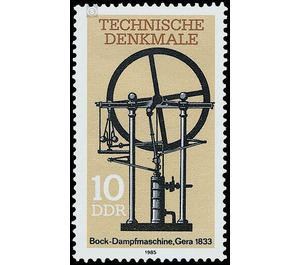Commemorative stamp series - Germany / German Democratic Republic 1985 - 10 Pfennig
Theme: Economy & Industry
| Country | Germany / German Democratic Republic |
| Issue Date | 1985 |
| Face Value | 10.00 |
| Color | brown |
| Perforation | K 14 |
| Printing Type | Rotogravure 2 |
| Stamp Type | Postage stamp |
| Item Type | Stamp |
| Chronological Issue Number | 2699 |
| Chronological Chapter | GER-DDR |
| SID | 293439 |
| In 20 Wishlists | |
Technical monuments - steam engines With the illustrations of historical steam engines, the Ministry of Posts and Telecommunications of the German Democratic Republic issues two multicolored special postage stamps. Special cancellations from July 9 to September 8, 1985 Technical monuments - steam engine 200 years ago, the first German Wattscher steam engine was built on the König-Friedrich-Schacht near Hettstedt and commissioned on August 23, 1785 for the recovery of water from the local copper shale mines , Previously there had been in England since 1712, in what is now the territory of the GDR since 1745 for the lifting of water in mines Newcomen machines, but only the Watt steam engine was suitable as an engine for the factories that in the wake of the Industrial Revolution - in England from 1770, in Germany from about 1800 - numerous emerged and gave rise to the formation of the bourgeoisie and the proletariat. According to this importance of the steam engine for the development of productive forces, the Hettstedter Steam Engine of 1785 marked the beginning of the construction and application of thousands of design, performance and application of different piston steam engines in Germany. Until the 20th century piston steam engines were used to drive the numerous machine tools and machine tools in the textile industry, mechanical engineering, mining and metallurgy and many other branches of production as well as in transport (steamer and steam locomotives). The commemoration year "200 years of the first German steam engine" gives occasion to open up the still preserved historical piston machines as technical monuments socially. On the special Postwertzeichen two of the oldest of the approximately 60 in the GDR still existing piston steam engines are presented. 10 Pfennig value: Bock steam engine The Bock steam engine of 1833 in Gera, set up in the yard of the company vocational school "Willi Strobelt", Talstraße 5, is the oldest piston steam engine received in the GDR. It was in the spinning mill of Jacob Anton Morand until 1885 in operation and initially served with eight horsepower power to drive five to six spinning machines, each with 200 spindles. As typical for the steam engines of the 18th and early 19th century, the machine has a vertical cylinder. The piston rod worked upwards and moved over the crank rod the crankshaft high above the cylinder with the flywheel of 3.3 m diameter. To the left of the flywheel, we recognize the centrifugal governor with its two spherical flyweights, which - moved by the crankshaft - throttles the steam supply more or less depending on the speed and thus keeps the speed of the machine almost constant at different loads. The name "Bock" steam engine refers to the scaffold, the "Bock", are mounted on the crankshaft and flywheel.


